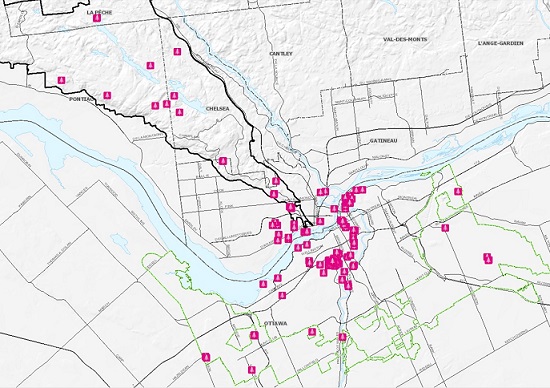Nature
Type of resources
Available actions
Topics
Keywords
Contact for the resource
Provided by
Years
Formats
Representation types
Update frequencies
status
Resolution
-

This dataset includes various offers related to nature and outdoor sports. Among other things, there are national and regional parks, wildlife reserves, equestrian centers, equestrian centers, marinas, skating rinks, beaches, downhill ski centers, cross-country ski centers, golf courses, ice fishing centers. Please note that this dataset is an overview of the tourist offer in Quebec and is not intended to identify the entire offer. This data comes from the Quebec Tourism Information System (SIT Quebec).**This third party metadata element was translated using an automated translation tool (Amazon Translate).**
-

Data on trees belonging to the municipality, referred to as “public domain”: street and off-street trees (parks and public squares). Please note that in many cases, the City's data on the spatial location of trees may be inaccurate or out of date. In addition, in some boroughs, park trees are not indicated.**This third party metadata element was translated using an automated translation tool (Amazon Translate).**
-

This dataset includes general category tourist accommodation establishments, whose types are: camping and caravanning or ready-to-camp sites. This data comes from the Quebec Tourism Information System (SIT Quebec). Please note that the posting of tourist accommodation establishments is governed by the Tourist Accommodation Act. The institutions in this dataset had a registration certificate in force at the time the file was published.**This third party metadata element was translated using an automated translation tool (Amazon Translate).**
-

This dataset lists offers for certain star activities of tourist businesses, activities offered to visiting customers. At the moment, there are 42 of the most popular activities on Quebec promotional tourist sites, for example: swimming, kayaking, downhill skiing, indoor climbing. Please note that this dataset is an overview of the tourist offer in Quebec and is not intended to identify the entire offer. This data comes from the Quebec Tourism Information System (SIT Quebec). Please note that this game is set to disappear in the fall of 2025, as all the information it contains will have been transferred to the other datasets as appropriate.**This third party metadata element was translated using an automated translation tool (Amazon Translate).**
-

This file contains polygons delimiting ecoterritories. The City of Montreal identified 10 sectors, called ecoterritories, where the protection and enhancement of the natural spaces located there were deemed to be a priority. These are vast territories of more than 15 hectares, bringing together existing protected areas (large parks, nature reserves, etc.), urbanized areas as well as natural areas that still need to be protected and developed. Ecoterritories were established by the Policy for the Protection and Development of Natural Environments (City of Montreal, 2004), which are recognized in the Montreal Urban Plan. This update of the ecoterritories follows the adoption of the new [Plan of land use and development of the agglomeration of Montreal] (https://montreal.ca/articles/schema-damenagement-et-de-developpement-de-lagglomeration-de-montreal-18112) and its entry into force on April 1, 2015.**This third party metadata element was translated using an automated translation tool (Amazon Translate).**
-

This dataset includes general category tourist accommodation establishments, such as outfitters. This data comes from the Quebec Tourism Information System (SIT Quebec). Please note that the posting of tourist accommodation establishments is governed by the Tourist Accommodation Act. The institutions in this dataset had a registration certificate in force at the time the file was published.**This third party metadata element was translated using an automated translation tool (Amazon Translate).**
-

The High Resolution Layer Ploughing indicator (PLOUGH) raster product continues the 2015 and 2018 PLOUGH Layer following a rolling archive principle by adding current information and removing historic years. It indicates the number of years since the last indication of ploughing within the permanent grassland area. PLOUGH is derived by taking into account the series of binary HER layers, the BVL classifications and HR VPP PPI (Plant Phenology Index) quantiles. BVL classes 4 (crop) and 7 (overlaying layer between herbaceous and crop) indicate a ploughing event. Low HR VPP PPI quantiles indicate low vegetation at a certain time of the year. For years with missing information (2016 and earlier) the ploughing information from the historic PLOUGH product is considered which causes some issues. This dataset is provided annually starting in 2017 with 10 meter rasters (fully conformant with the EEA reference grid) in 100 x 100 km tiles covering the EEA38 countries. High Resolution Layer Grasslands product is part of the European Union’s Copernicus Land Monitoring Service. This dataset includes data from the French Overseas Territories (DOMs)
-

In celebration of the tremendous diversity of tree species that tell the story of our culture and history, the NCC released in September 2020 a compilation of close to 170 remarkable trees across Canada’s Capital region entitled A Living Legacy: Remarkable Trees of Canada’s Capital. An interactive map and downloadable book are available for free on the NCC’s website and will allow the public to discover distinctive features of these trees, revealing a story of the beauty of our natural heritage through the rich diversity of species thriving within Canada’s Capital. This compilation features trees according to their commonalities, which can include their physical relationship with the land, the fact that they were a source of food for Indigenous peoples, or for their contribution to the forest industry. https://ncc-ccn.gc.ca/remarkable-trees https://ncc-ccn.maps.arcgis.com/apps/MapJournal/index.html?appid=a9ba98fb7e8b4c2ba9be337235b95291
-

This data set contains the polygons delimiting the natural wastelands of the Montreal agglomeration. The boundaries of the wastelands and their type are the result of an analysis of aerial photos and/or of field visits and/or of particular ecological studies. These are constantly updated in accordance with the advancement of knowledge in the community. Some types and their limits may therefore be imprecise.**This third party metadata element was translated using an automated translation tool (Amazon Translate).**
-

The High Resolution Layer Grassland Change (GRAC) 2018-2021 raster product at 20m resolution provides information on changes in grassland vegetation cover between the reference years 2018 and 2021. The thematic classes indicate all non-grassland areas, grassland gain and grassland loss, unchanged grassland in both years and unverified grassland gain and loss areas. This dataset is provided in 20 meter rasters (fully conformant with the EEA reference grid) in 100 x 100 km tiles covering the EEA38 countries. High Resolution Layer Grasslands product is part of the European Union’s Copernicus Land Monitoring Service. Confidence layer available for the dataset. This dataset includes data from the French Overseas Territories (DOMs)
 Arctic SDI catalogue
Arctic SDI catalogue